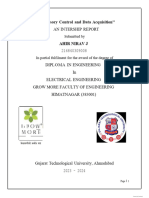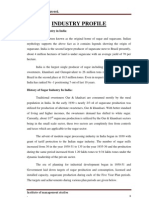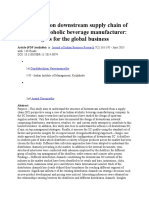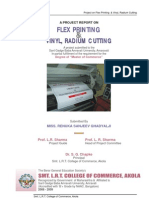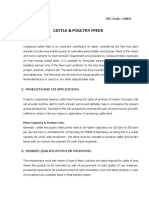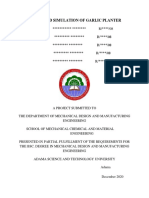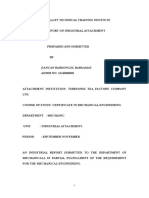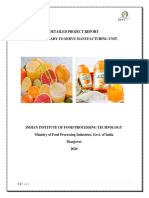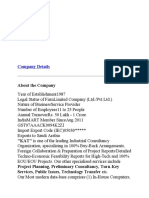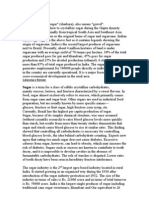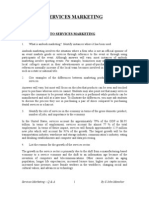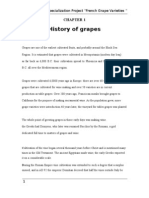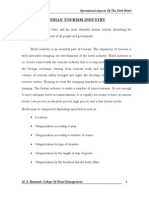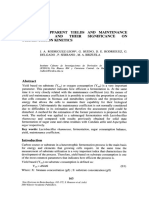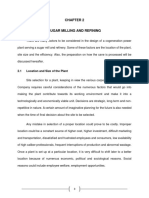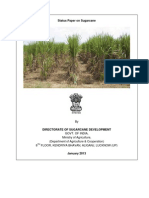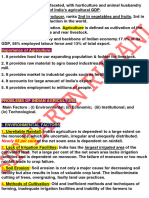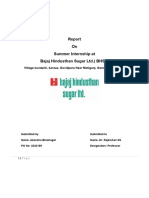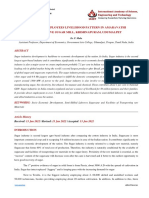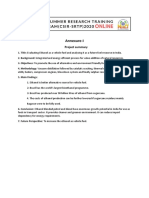Indian Sugar Industry Introduction
Indian Sugar Industry Introduction
Uploaded by
jayeshvkCopyright:
Available Formats
Indian Sugar Industry Introduction
Indian Sugar Industry Introduction
Uploaded by
jayeshvkCopyright
Available Formats
Share this document
Did you find this document useful?
Is this content inappropriate?
Copyright:
Available Formats
Indian Sugar Industry Introduction
Indian Sugar Industry Introduction
Uploaded by
jayeshvkCopyright:
Available Formats
Sugar is one of the oldest commodities in the world and traces its origin in 4th
century AD in India and China. In those days sugar was manufactured only from
sugarcane. But both countries lost their initiatives to the European, American and
Oceanic countries, as the eighteenth century witnessed the development of new
technology to manufacture sugar from sugar beet. However, India is presently a
dominant player in the global sugar industry along with Brazil in terms of production.
Given the growing sugar production and the structural changes witnessed in Indian
sugar industry, India is all set continue its domination at the global level. Indian
sugar industry is highly fragmented with organized and unorganized players. The
unorganized players mainly produce Gur and Khandari, the less refined forms of sugar.
The government had a controlling grip over the industry, which has slowly yet steadily
given way to liberalization.
The production sugarcane is cyclical in nature. Hence the sugar production is
also cyclical as it depends on the sugarcane production in the country. As the industry is
a fragmented one, even leading players do not control more than 4 percent market in
India. However, the situation is changing and players off late are striving to increase
their market share either by acquiring smaller mills or by going for green field capacity
additions.
Indian sugar industry can be broadly classified in to two sub sectors, the
organized sector i.e. sugar factories and the unorganized sector i.e. manufacturers of
traditional sweeteners like gur and khandsari. The latter is considered to be a rural
industry and enjoys much greater freedom than sugar mills.
The production of traditional sweeteners gur and khandsari is quite substantial.
Though the trends indicate a progressive shift from traditional sweeteners to white
sugar over the years, they still account for about 37% of total sweetener consumption in
India.
Since the sugar industry in the country uses only sugarcane as an in input, sugar
companies have been established in large cane growing states like Uttar Pradesh,
Maharashtra, Tamil Nadu, Karnataka, Punjab and Gujarat. Uttar Pradesh leads the tally
by contributing 24% of the countries total sugar production and Maharashtra stands
next with 20% contribution.
The farmers co-operatives own and operate the largest chunk of the industry's
total capacity. They are concentrated primarily in Maharashtra and eastern Uttar
Pradesh. The largest number of sugar companies in the private sector are located in
southern India, in the states of Tamil Nadu, Andhra Pradesh and Karnataka.
Out of 453 sugar mills in the country, 252 are in the co-operative sector, 134 are
in the private sector and 67 are in the public sector. Besides 136 units in the private
sector are in various stages of implementation. A Few such units are under
implementation in the co-operative sector as well. But no new units have been proposed
in the public sector.
You might also like
- RSGBL ProjectDocument43 pagesRSGBL ProjectRani ShahNo ratings yet
- Company ProfileDocument14 pagesCompany ProfilerobNo ratings yet
- Sugar Manufacturing Industry. Mini Sugar Plant. Sugarcane Mill. - 11896Document68 pagesSugar Manufacturing Industry. Mini Sugar Plant. Sugarcane Mill. - 11896MahantNo ratings yet
- Proposed Project - Geer RD Solar Project, LLC.Document119 pagesProposed Project - Geer RD Solar Project, LLC.mike doudNo ratings yet
- Internship ReportDocument36 pagesInternship ReportSukumar SNo ratings yet
- ShivprbhuDocument58 pagesShivprbhuShiv Prabhu AntinNo ratings yet
- Internship ReportDocument40 pagesInternship Reportahirnirav2205No ratings yet
- Industry Profile: K.S.S.K LTD, HaveriDocument42 pagesIndustry Profile: K.S.S.K LTD, HaveriManju PalegarNo ratings yet
- Bottling Plant Whisky Brandy Rum Vodka Gin From Rectified Spirit EnaDocument3 pagesBottling Plant Whisky Brandy Rum Vodka Gin From Rectified Spirit EnaAbhimanyu Singh BhatiNo ratings yet
- HP InternDocument31 pagesHP Internanon_61445783650% (2)
- KCP Sugar Oct Visit 26.10.2019Document9 pagesKCP Sugar Oct Visit 26.10.2019azeem dilawarNo ratings yet
- Term Paper: Master of Buisness ApplicationDocument28 pagesTerm Paper: Master of Buisness Applicationashishsuman50% (2)
- Project Report PAPADDocument3 pagesProject Report PAPADsagayapriya50% (2)
- Roller Flour Mill - Atta Maida & SujiDocument4 pagesRoller Flour Mill - Atta Maida & Sujikumari shaliniNo ratings yet
- Investor Presentation August 2016 (Company Update)Document40 pagesInvestor Presentation August 2016 (Company Update)Shyam SunderNo ratings yet
- YuvrajDocument28 pagesYuvrajpradipNo ratings yet
- Process Control Instrumentation Polytechnic Books PDF DownloadDocument92 pagesProcess Control Instrumentation Polytechnic Books PDF DownloadVaibhav ChoudhariNo ratings yet
- Sugar Factory Report NewDocument29 pagesSugar Factory Report NewMonika PatilNo ratings yet
- Project Profile of Edible OilDocument47 pagesProject Profile of Edible OilManish Bhoyar100% (2)
- A Case Study On Downstream Supply Chain of An Indian Alcoholic Beverage ManufacturerDocument25 pagesA Case Study On Downstream Supply Chain of An Indian Alcoholic Beverage Manufacturertsega-alem berihu100% (1)
- How To Start Mustard Oil Mill. Profitable Business Idea. Business With Huge Profit in India-339280Document68 pagesHow To Start Mustard Oil Mill. Profitable Business Idea. Business With Huge Profit in India-339280Jotirmoy AichNo ratings yet
- Sangat Mustard Oil Business PlanDocument15 pagesSangat Mustard Oil Business PlanSahil Singla100% (1)
- MRK Sugar MillsDocument15 pagesMRK Sugar MillsVasanth Kumar100% (1)
- Rice Bran Oil Extraction Unit Rs. 566.62 Million Feb-2021Document23 pagesRice Bran Oil Extraction Unit Rs. 566.62 Million Feb-2021Saeed AkhtarNo ratings yet
- Capital Investment Ashok Sahakari Sakhar KarkhanaDocument59 pagesCapital Investment Ashok Sahakari Sakhar Karkhanaakshaykhade9834No ratings yet
- Pro S09 RenukaDocument65 pagesPro S09 RenukabhakteeNo ratings yet
- Project Beer MFGDocument77 pagesProject Beer MFGmickky003vivek100% (3)
- Bread Factory-5lDocument12 pagesBread Factory-5lGolden Shower தமிழ்No ratings yet
- Cattle & Poultry FeedDocument9 pagesCattle & Poultry FeedKamalMahalkaNo ratings yet
- Project Fin44Document62 pagesProject Fin44SidNo ratings yet
- Agarbatti Making ProjectDocument22 pagesAgarbatti Making ProjectSatyabrat SahooNo ratings yet
- Summer Training ReportDocument81 pagesSummer Training ReportAmitTewariJr.No ratings yet
- Garlic PlanterDocument75 pagesGarlic PlanterAbel AregayNo ratings yet
- West Kenya Sugar CompanyDocument42 pagesWest Kenya Sugar CompanystephenbwogoraNo ratings yet
- Nirma Project WordDocument83 pagesNirma Project WordKv RaluNo ratings yet
- Sugar Factory IntroductionDocument31 pagesSugar Factory IntroductionVihang DesaiNo ratings yet
- Sugar Manufacturing Process DiscriptionDocument6 pagesSugar Manufacturing Process DiscriptionMuhammad Junaid0% (1)
- Review On Recent Advances in Value Addition of Jaggery Based Products 2157 7110 1000440Document4 pagesReview On Recent Advances in Value Addition of Jaggery Based Products 2157 7110 1000440kumari shaliniNo ratings yet
- ProposalDocument17 pagesProposalJimmy Reece100% (1)
- Case - MR Brown BakeryDocument3 pagesCase - MR Brown BakeryVishek Agarwal100% (3)
- Sugar Factory Internship ReportDocument54 pagesSugar Factory Internship Report15, Sweekar Chougale100% (1)
- Wongi Sugar FactoryDocument70 pagesWongi Sugar FactoryHana KabedeNo ratings yet
- Detailed Project Report ON Auto Loom / Rapier Loom (4 Nos) (Solapur Textile Cluster)Document46 pagesDetailed Project Report ON Auto Loom / Rapier Loom (4 Nos) (Solapur Textile Cluster)Umesh KumarNo ratings yet
- United Breweries LimitedDocument9 pagesUnited Breweries LimitedMorningLight100% (7)
- Bakery Products Final Project Report - CD VersionDocument63 pagesBakery Products Final Project Report - CD VersionKavi RehabianNo ratings yet
- A Project On The Spinning Industry of India: BY Deepak Luniya Roll No: 290Document45 pagesA Project On The Spinning Industry of India: BY Deepak Luniya Roll No: 290deepakluniyaNo ratings yet
- Project Report On Ngo in Koraput District in OdishaDocument39 pagesProject Report On Ngo in Koraput District in OdishaSambeet ParidaNo ratings yet
- Roquette Training Project ReportDocument46 pagesRoquette Training Project ReportNèéřåj SîñğhNo ratings yet
- Detailed Project Report Orange Ready To Serve Manufacturing UnitDocument38 pagesDetailed Project Report Orange Ready To Serve Manufacturing UnitKRISHNA TANEJA TANEJANo ratings yet
- Manufacturing of Api and IntermediatesDocument34 pagesManufacturing of Api and IntermediatesShaileshNo ratings yet
- Essential Oils Distillation Unit Rs. 9.33 Million Jun-2018Document17 pagesEssential Oils Distillation Unit Rs. 9.33 Million Jun-2018Rana Muhammad Ayyaz RasulNo ratings yet
- Spinning Mill ProjectDocument10 pagesSpinning Mill ProjectAtoZdigital Service CenterNo ratings yet
- Project ReportDocument40 pagesProject ReportNitika KatariaNo ratings yet
- Literature ReviewDocument20 pagesLiterature ReviewArpita Agarwal100% (2)
- Financial Performance Analysis of The Select Sugar Mills in Tamil Nadu Introduction and Research DesignDocument18 pagesFinancial Performance Analysis of The Select Sugar Mills in Tamil Nadu Introduction and Research DesignHassam gulzaibNo ratings yet
- Manju Final ReportDocument68 pagesManju Final ReportnaglikarNo ratings yet
- Sakthi Sugars Appakoodal Intern ReportDocument32 pagesSakthi Sugars Appakoodal Intern ReportIndu Mathi Thyagarajan100% (3)
- 02 SynopsisDocument16 pages02 Synopsislucifer1711No ratings yet
- Rajashekhar ChimilagiDocument79 pagesRajashekhar ChimilagiHarshal Borgaon100% (1)
- Organization Study at Chamundeshwari SugarDocument18 pagesOrganization Study at Chamundeshwari SugarArun Sankar PNo ratings yet
- Service MKTG QuestionsDocument42 pagesService MKTG Questionsjayeshvk80% (5)
- Change ManagementDocument113 pagesChange Managementjayeshvk97% (38)
- Projects On Fosters BeerDocument51 pagesProjects On Fosters Beerjayeshvk100% (3)
- Leela Palace Hotel Project, BangaloreDocument235 pagesLeela Palace Hotel Project, Bangalorejayeshvk100% (68)
- Fosters Beer PresentationDocument11 pagesFosters Beer Presentationjayeshvk100% (2)
- Le Meridian, BangaloreDocument150 pagesLe Meridian, Bangalorejayeshvk100% (10)
- Project Report On The Bristol Hotel (India, Hariyana)Document95 pagesProject Report On The Bristol Hotel (India, Hariyana)jayeshvk99% (104)
- Introduction To The Hotel IndustryDocument10 pagesIntroduction To The Hotel Industryjayeshvk100% (18)
- French Grape VarietiesDocument83 pagesFrench Grape Varietiesjayeshvk100% (3)
- Indian Tourism IndustryDocument7 pagesIndian Tourism Industryjayeshvk100% (7)
- MIS Hotel Project of Hotel ParkDocument179 pagesMIS Hotel Project of Hotel ParkGeetha GovindanNo ratings yet
- International Business Management As Per VTUDocument141 pagesInternational Business Management As Per VTUjayeshvk97% (62)
- Hoticulture 2Document20 pagesHoticulture 2Alishba SherazNo ratings yet
- True and Apparent Yields Coefficient AND Their Fermentation Kinetics and Maintenance Significance ONDocument10 pagesTrue and Apparent Yields Coefficient AND Their Fermentation Kinetics and Maintenance Significance ONkevsus3No ratings yet
- Fatima Transmission Company Administration 12Document38 pagesFatima Transmission Company Administration 12Haider SarwarNo ratings yet
- 2.1 Location and Size of The PlantDocument21 pages2.1 Location and Size of The PlantRizelle VinaraoNo ratings yet
- Agriculture Notes Final UpdatedDocument20 pagesAgriculture Notes Final UpdatedWahab SulemanNo ratings yet
- Studies On Barrel Type CarbonizerDocument89 pagesStudies On Barrel Type Carbonizerjaheer1222100% (1)
- Ipm of Sugarcane Crop PestsDocument9 pagesIpm of Sugarcane Crop PestsAbdul GhaffarNo ratings yet
- New Book With Dr. Sri MarmoahDocument125 pagesNew Book With Dr. Sri Marmoahstefi yolandaNo ratings yet
- Quarantine Requirements For The Importation of Plants or Plant Products Into The Republic of ChinaDocument109 pagesQuarantine Requirements For The Importation of Plants or Plant Products Into The Republic of ChinaConstans IbacacheNo ratings yet
- Determination of Sugar Solutions Color According To ICUMSA / Application Note Analytical ChemistryDocument18 pagesDetermination of Sugar Solutions Color According To ICUMSA / Application Note Analytical Chemistrylamperouge221No ratings yet
- Status Paper On SugarcaneDocument16 pagesStatus Paper On SugarcanedonbosskissNo ratings yet
- FPE REPORT Sugarcane JuiceDocument21 pagesFPE REPORT Sugarcane JuiceAini SyakirahNo ratings yet
- Para Grass Risk AssessmentDocument28 pagesPara Grass Risk AssessmentFarm MagazineNo ratings yet
- Min Ramos VarietyDocument1 pageMin Ramos VarietyGrignionNo ratings yet
- Is Soil Quality A Concern in Sugarcane Cultivation PDFDocument8 pagesIs Soil Quality A Concern in Sugarcane Cultivation PDFMicke HerreraNo ratings yet
- 075 FullDocument9 pages075 FullPhani ArvapalliNo ratings yet
- Cenvat Credit On Welding ElectrodesDocument24 pagesCenvat Credit On Welding ElectrodesRatanaRoul100% (1)
- Climate ChangeDocument10 pagesClimate ChangesomiNo ratings yet
- Profile To PrintDocument10 pagesProfile To PrintSuhailShaikhNo ratings yet
- Unit 9 Industrial Development Secondary and Tertiary IndustriesDocument22 pagesUnit 9 Industrial Development Secondary and Tertiary IndustriesAbdullah Lateef100% (1)
- Equipments Used in Sugar Industry: By-M.ManojDocument7 pagesEquipments Used in Sugar Industry: By-M.Manojashok rajNo ratings yet
- Cleaning Up Jaggery: Shree Padre, MudholDocument4 pagesCleaning Up Jaggery: Shree Padre, Mudholkaushal ahirwarNo ratings yet
- Experiment No.2 Sowing Methods of SugarcaneDocument4 pagesExperiment No.2 Sowing Methods of Sugarcanejain sparshNo ratings yet
- 7,8,9. AgricultureguioDocument30 pages7,8,9. Agricultureguioamit072648No ratings yet
- Report On Noon Sugar MillsDocument81 pagesReport On Noon Sugar MillsLion HeartNo ratings yet
- SIP Report by Akansha BhatnagarDocument55 pagesSIP Report by Akansha Bhatnagarvartika vermaNo ratings yet
- Ijhss - A Study On Employees Livelihood Pattern in Amaravathi Co-Operative Sugar Mill, Krishnapuram, Udumalpet. - 1Document8 pagesIjhss - A Study On Employees Livelihood Pattern in Amaravathi Co-Operative Sugar Mill, Krishnapuram, Udumalpet. - 1iaset123No ratings yet
- Annexure-I: Project SummaryDocument9 pagesAnnexure-I: Project SummaryadityamduttaNo ratings yet
- Global Sugar - A Complex Market That Requires A Fit For Purpose CTRM SolutionDocument13 pagesGlobal Sugar - A Complex Market That Requires A Fit For Purpose CTRM SolutionCTRM CenterNo ratings yet
- Md30.1 Flender Sig enDocument300 pagesMd30.1 Flender Sig enFitra VertikalNo ratings yet






